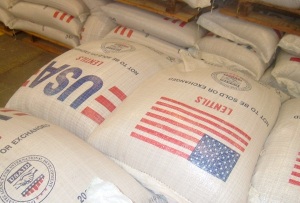Reforming US Food Aid
 A couple of weeks ago, I blogged on President Obama’s proposed reforms to the US food aid system. The proposal centers on three long overdue changes: shifting a portion of aid programming from in-kind to cash-based aid, eliminating the requirement that U.S. food aid be shipped on U.S. flagged vessels, and ending the practice of monetizing food aid. As I noted at the time, the changes would have the effect of making US food aid both more efficient and more beneficial for recipient countries in the developing world.
A couple of weeks ago, I blogged on President Obama’s proposed reforms to the US food aid system. The proposal centers on three long overdue changes: shifting a portion of aid programming from in-kind to cash-based aid, eliminating the requirement that U.S. food aid be shipped on U.S. flagged vessels, and ending the practice of monetizing food aid. As I noted at the time, the changes would have the effect of making US food aid both more efficient and more beneficial for recipient countries in the developing world.
Blogging at Triple Crisis, Jennifer Clapp points out another benefit. As she notes,
This institutional change is what the US is currently attempting – to move food aid policymaking out of the clutches of the agricultural policymaking setting of the Farm Bill, and into the development policymaking arena of the US Agency for International Development. Without this institutional shift, it is unlikely that US food aid could be untied.
She’s absolutely correct here. The reform of US food aid along the proposed lines would represent a significant transformation, marking a shift from a US-focused food aid system to a development-focused food aid system. If anything, Clapp understates the scope of the proposed changes. The current US food aid system was developed in 1954 as a tool to deal with the excess food production in the United States. It was, in essence, a surplus disposal mechanism. Additionally, Public Law (PL) 480, the act that essentially established the US food aid program, laid out three additional goals for the program beyond surplus disposal. They were: development and expansion of export markets for US agricultural commodities, promotion of sustainable development, and limiting the impact of hunger and malnutrition.
A 2002 USAID report (subsequently removed from their website), stated that,
The principal beneficiary of America’s foreign assistance has always been the United States. Close to 80 percent of the US Agency for International Development’s (USAID’s) contracts go directly to American firms. Foreign assistance programs have helped the United States by creating major export markets for agricultural goods, new markets of industrial exports, and hundreds of thousands of American jobs. (See AidWatch or Jamieson’s “Duties to the Distant.” The original quotation appeared in a United States Agency for International Development report entitled “Direct Economic Benefits of US Assistance Programs (By State),” which is no longer publically available).
All of this suggests that the political struggle over restructuring US food aid is likely to be long. Yet Clapp is optimistic, noting that the framing of the issue in terms of efficiency and budget cuts may resonate with Congress, particularly in an age of austerity. The renegotiation of the US Farm Bill also opens possibilities for reform. Here’s to hope…
Reblogged this on drbausman's Blog.